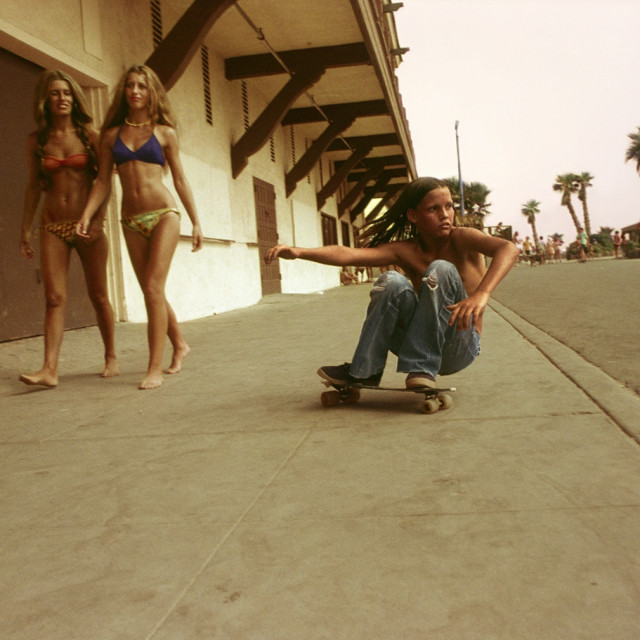M+B is pleased to present Angels, the first exhibition of color photographs by artist Hugh Holland. In ANGELS, Holland presents an intriguing portrait of a generation of boys discovering their identity amidst the drainage bowls and emptied pools of Los Angeles during the skateboarding revolution of the mid-Seventies. With his distinct style, Holland transforms a group of boys normally regarded as tough street kids into angels.
As far as youth culture is concerned, skateboarding is one of the most influential and dominating cultural phenomena to define a generation of kids during the latter half of the twentieth century and still continues to this day. In the mid-Seventies, two events coincided in Southern California that gave rise to skateboarding as we now know it: the invention of the urethane wheel provided the traction and shocks that the earlier clay wheels lacked, and the drought that emptied the pools across the city allowed the kids to ride their new boards in an entirely new way. Groups of kids from all neighborhoods and backgrounds in Los Angeles began hitting the pavement after school and during the summer, creating a counter-culture that has inspired numerous books, songs, documentaries and, recently, a major motion picture.
One summer morning in 1975, a young photographer from Oklahoma named Hugh Holland was driving up Laurel Canyon when he noticed a group of boys gracefully weaving up and down the drainage bowls that line the road. Although not a skateboarder himself, Holland was a photographer of the figure and was immediately captivated by the movement and energy exuding from this group of skaters. Parking his car on the side of the road, Holland began photographing the boys, a personal project that would quickly consume his afternoons, weekends and summers for the next three years. These first boys he befriended and photographed were canyon kids from the hills, who would soon hang with the legendary Z-boys from Santa Monica and Venice and other groups of skaters from all over the west side at the school yard banks of Kenter Canyon, Paul Revere and Brentwood, and eventually, at the emptied pools of the nearby neighborhoods where the real revolution would take place. Holland, with a camera and a car, immediately became a part of the group, driving them from skate spot to skate spot and providing them with documented proof of their triumphs. He photographed them all: from flatland kids still doing "freestyle" to the canyon kids going vertical to soon-to-be legends Stacy Peralta and Jay Adams recklessly carving up the pools.
Unlike most photographers capturing the craze, Holland's photographs were never about the sport. Holland shot with an old color negative movie film, rendering his images in warm, soft tones that were in complete contrast to the sharp, crisp chromes that the majority of skate photographers were using. His representation reveals the boys in a more ethereal and angelic light, and they appear to be floating and gliding across the banks of cement. Beyond the bodies in motion, Holland captures beautifully intimate portraits of the young boys sitting under the trees waiting their turn, resting by the chain link fence at Kenter or in peaceful contemplation after a long day of riding. The photographs have an underlying erotic quality, unlike typical photographs of skateboarders that concentrate on the dynamics of the hard-edged sport. Holland primarily shot his subjects in the late afternoon, bathing his models and settings with an effervescent, glistening quality. They are, in essence, photographs of a generation of boys discovering their identity amidst the backdrop of cultural phenomena that shaped a generation.
A monograph on Hugh Holland's skateboading photographs included in the exhibition is currently being published by Greybull Press.
Hugh Holland: Angels: Street, Skate, Seventies
Past exhibitions exhibition

